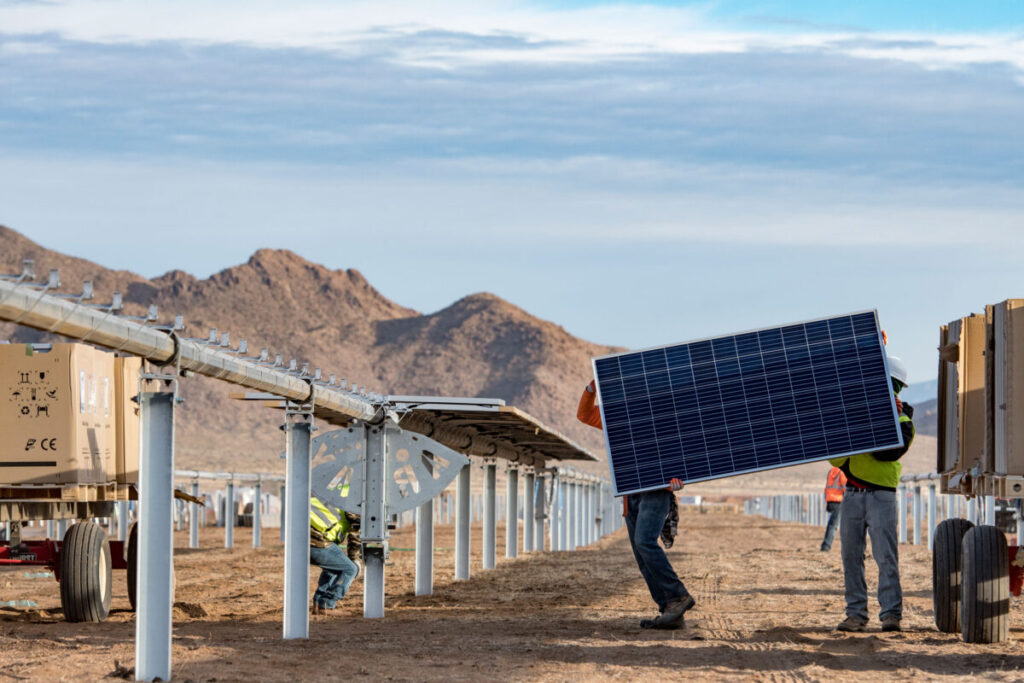
The US has installed 17.92GW of new solar capacity in the first half of the year, with quarter-on-quarter declines in capacity additions for the utility-scale and residential sectors.
These are the headline figures from the latest report into the US solar sector from the Solar Energy Industries Association (SEIA) and Wood Mackenzie, which was published yesterday (08 September) and covers the second quarter of the year.
Try Premium for just $1
- Full premium access for the first month at only $1
- Converts to an annual rate after 30 days unless cancelled
- Cancel anytime during the trial period
Premium Benefits
- Expert industry analysis and interviews
- Digital access to PV Tech Power journal
- Exclusive event discounts
Or get the full Premium subscription right away
Or continue reading this article for free
The rate of new capacity additions has also slowed notably, with 7.5GW of new capacity added in the second quarter of this year, down 28% from the previous quarter, and down 24% from the same period of the previous year.
The trade association places much of the blame for this slowdown in deployment on the Trump administration, particularly the passage of the ‘One Big, Beautiful Bill’, which has shortened the timeframe for which renewable energy projects can benefit from tax credits guaranteed by the Biden-era Inflation Reduction Act (IRA).
A report from sustainable finance company Crux, published in June, said that uncertainty regarding timelines and eligibility for these tax credits could create “higher costs of capital” in US solar, and make investors less willing to support new projects.
As a result, SEIA is starting to revise down some of its forecasts for US solar deployment to the end of 2030. The trade association now expects 2025 capacity additions to fall below the record 50GW installations reported in 2025, which would mark the first time US capacity installations have fallen year-on-year since 2021-2022.
SEIA’s most cautious forecast for deployment figures by 2030, compared to predictions made before the passage of the ‘One Big, Beautiful Bill’, estimate the US installing 55GW less new solar capacity by the end of the decade, a 21% decline. Indeed, SEIA expects the US to install more than 40GW of new capacity only twice between 2026 and the end of the decade – in 2026 and 2027 – and for year-on-year capacity additions to fall each year from 2027 to 2030.
The slowdown in installations is shown in the graph above, with annual capacity additions, across all sectors, in yellow. Indeed, capacity additions in utility-scale and residential solar were down both year-on-year and quarter-on-quarter.
The US added 5.7GW of utility-scale solar in the second quarter of this year, a 33% quarter-on-quarter decline, while the residential sector added just over 1GW of new capacity, a 3% decline from the first quarter of the year. However, SEIA notes that the commercial sector performed better, adding 585MW of new capacity in the second quarter of the year, a 27% increase over the same period of 2024 and a record for second quarter additions in this sector.
The SEIA-Wood Mackenzie report also notes that the cost of solar installations continues to fall; the cost of installing an “average-sized” residential system has fallen from around US$40,000 in 2010 to around US$26,880 today. SEIA president and CEO, Abigail Ross Hopper, said solar has “the lowest cost to families and businesses” among power generation technologies, and the competitive prices of solar installations have long been an attractive component of the industry.
However, the graph also shows that, in the last decade, the rate of price declines has fallen, with all three sectors profiled showing price increases in recent years.
Indeed, between 2025 and the first half of 2025, the average price of a PV system has increased in all three sectors – utility-scale, commercial and residential – reflecting the growing cost of solar amid continuing market and policy uncertainty.
“Instead of unleashing this American economic engine, the Trump administration is deliberately stifling investment, which is raising energy costs for families and businesses, and jeopardising the reliability of our electric grid,” added Hopper.
Solar and storage account for 82% of all capacity additions
Despite this slowdown in capacity additions, solar continues to be a key part of new US power generation additions, particularly alongside batteries. The SEIA-Wood Mackenzie report notes that, in the first half of 2025, solar accounted for a record 69% of all new generating capacity additions, the largest proportion accounted for by any single technology in any year since 2010.
Storage systems accounted for 13% of new capacity additions in the first half of the year, pushing solar and storage’s combined contributions to new US energy additions to 82%, a shade under the record 84% set by these technologies last year. Wind was responsible for a further 17%, leaving all other technology types, including all fossil fuels, to account for just 5% of new capacity additions in the first half of the year.
SEIA notes that, between 2023 and 2024, the percentage of residential solar projects co-located with battery energy storage systems (BESS) more than doubled from 12% to 28%. Much of this has been driven by the passage of the net energy metering (NEM 3.0) scheme in California.
While the bill has drawn criticism for dissuading investments in standalone residential solar, the effects on the storage sector are evident; between October 2023 and April 2024, the rate of residential systems installed with batteries increased from just over 20% to just over 50%.
Considering the role that batteries can play in providing grid-forming services, and reducing some of the variance in renewable power generation that has historically been unattractive for potential investors, the continued growth of the storage sector in the US could be critical to add certainty back to the US energy transition.






